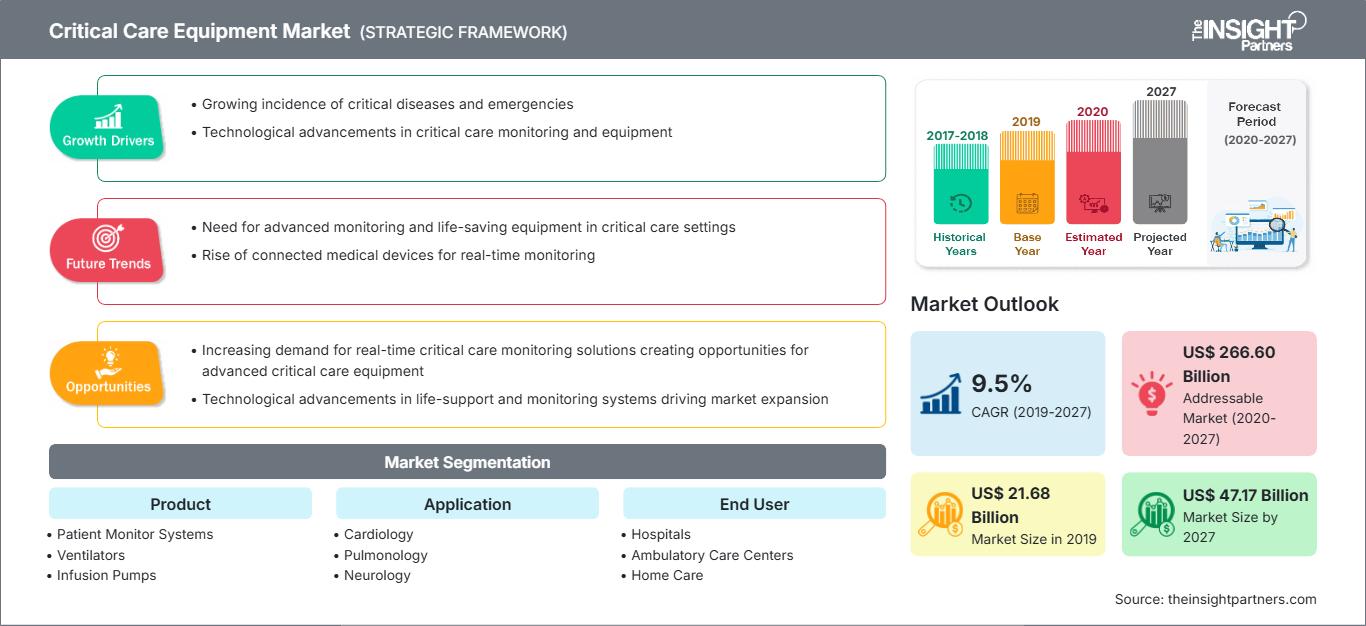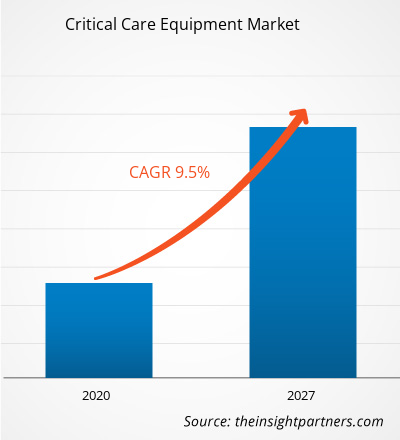El mercado de equipos de cuidados intensivos se valoró en 21.682,65 millones de dólares estadounidenses en 2019 y se prevé que alcance los 47.171,42 millones de dólares estadounidenses en 2027; se espera que crezca a una tasa de crecimiento anual compuesta (TCAC) del 9,5% durante el período 2020-2027.
Una cama de UCI está equipada y cuenta con personal capacitado para brindar atención de nivel intensivo, incluyendo ventilación mecánica y monitorización invasiva. Según el Centro Nacional de Información Biotecnológica, en mayo de 2020, cuando Canadá se encontraba en el pico del brote de COVID-19, la necesidad de camas de UCI superó con creces los niveles habituales, incluso con un 40% de la población en aislamiento. El número de camas de UCI disponibles en cada región oscilaba entre 0,63 y 1,85 por cada 10.000 habitantes. Suponiendo una tasa de ocupación actual estimada del 80%, las camas de UCI disponibles para pacientes con COVID-19 variarían entre 0,13 y 0,37 por cada 10.000 habitantes en toda la región.
Los pacientes con la infección permanecen un promedio de 15 días en la UCI. Según la Sociedad Europea de Anestesiología, el número de camas de cuidados intensivos en Italia sigue aumentando. En Lombardía, antes de la propagación del coronavirus, había 140 camas de UCI privadas y 500 públicas, cifra que aumentó a más de 900 a finales de marzo de 2020.
Obtendrá personalización gratuita de cualquier informe, incluyendo partes de este informe, análisis a nivel de país y paquetes de datos de Excel. Además, podrá aprovechar excelentes ofertas y descuentos para empresas emergentes y universidades.
Mercado de equipos de cuidados intensivos: Perspectivas estratégicas

- Obtenga las principales tendencias clave del mercado que se describen en este informe.Esta muestra GRATUITA incluirá análisis de datos, que abarcarán desde tendencias de mercado hasta estimaciones y pronósticos.
Perspectivas del mercado
El creciente número de camas de UCI en países con alta prevalencia de COVID-19 impulsará el crecimiento del mercado.
La Organización Mundial de la Salud declaró la COVID-19 como pandemia mundial el 11 de marzo de 2020. Esta nueva enfermedad se caracteriza por un número inicial reducido de casos, seguido de un aumento exponencial de contagios en diversos países. A pesar de las medidas de confinamiento implementadas para frenar la propagación de la COVID-19, los sistemas sanitarios de varios países se han visto desbordados por la demanda de equipos, como camas de UCI y material de apoyo para el tratamiento de los casos graves.
Información sobre productos
En cuanto a productos, el segmento de sistemas de monitorización de pacientes ostentó la mayor cuota de mercado en 2019 y se prevé que continúe siendo líder durante el período de pronóstico. Sin embargo, se espera que el segmento de ventiladores registre una mayor tasa de crecimiento anual compuesto (TCAC) durante dicho período.
Información de la aplicación
Según su aplicación, el mercado mundial de equipos de cuidados intensivos se segmenta en cardiología, neumología, neurología, ortopedia y otros. El segmento de cardiología ostentó la mayor cuota de mercado en 2019, y se prevé que el segmento de neumología registre la mayor tasa de crecimiento anual compuesto (TCAC) durante el período de pronóstico. Los cuidados intensivos cardiovasculares (CIC) constituyen el manejo integral de pacientes con enfermedad cardiovascular (ECV) grave, incluyendo enfermedades vasculares y cardíacas. La ECV se encuentra entre las principales causas de muerte a nivel mundial. Por ejemplo, según la Organización Mundial de la Salud, en 2016 se estima que 17,9 millones de personas fallecieron por ECV, lo que representa el 31 % de las muertes en todo el mundo. De manera similar, según los Centros para el Control y la Prevención de Enfermedades (CDC), aproximadamente 655 000 estadounidenses mueren cada año por enfermedades cardíacas. Para prevenir la muerte por ECV, los hospitales generales cuentan con unidades de cuidados intensivos para pacientes con ECV grave, conocidas como unidades de cuidados intensivos cardiovasculares (UCIC). Los avances tecnológicos en cardiología clínica, como los procedimientos y dispositivos de intervención intracoronaria y la monitorización hemodinámica invasiva, representan la principal evolución de los cuidados intensivos para enfermedades cardiovasculares. En consecuencia, el número de pacientes con enfermedades cardiovasculares graves ingresados en la UCIC aumenta cada año. Estos pacientes presentan numerosas complicaciones, como insuficiencia respiratoria e insuficiencia renal. Por lo tanto, se requiere personal médico capacitado para brindar cuidados intensivos sistémicos.
Se prevé que las colaboraciones y las alianzas tecnológicas entre los participantes del mercado de equipos de cuidados intensivos para cerrar la brecha entre la oferta y la demanda desempeñen un papel importante en el crecimiento del mercado durante el período de pronóstico.
Perspectivas regionales del mercado de equipos de cuidados intensivos
Los analistas de The Insight Partners han explicado en detalle las tendencias y los factores regionales que influyen en el mercado de equipos de cuidados intensivos durante el período de previsión. Esta sección también analiza los segmentos y la geografía del mercado de equipos de cuidados intensivos en Norteamérica, Europa, Asia Pacífico, Oriente Medio y África, y Sudamérica y Centroamérica.
Alcance del informe de mercado de equipos de cuidados críticos
| Atributo del informe | Detalles |
|---|---|
| Tamaño del mercado en 2019 | US$ 21.680 millones |
| Tamaño del mercado para 2027 | 47.170 millones de dólares estadounidenses |
| Tasa de crecimiento anual compuesto global (2019 - 2027) | 9,5% |
| Datos históricos | 2017-2018 |
| período de previsión | 2020-2027 |
| Segmentos cubiertos | Por producto
|
| Regiones y países cubiertos | América del norte
|
| Líderes del mercado y perfiles de empresas clave |
|
Densidad de los actores del mercado de equipos de cuidados críticos: comprensión de su impacto en la dinámica empresarial
El mercado de equipos para cuidados intensivos está creciendo rápidamente, impulsado por la creciente demanda de los usuarios finales debido a factores como la evolución de las preferencias de los consumidores, los avances tecnológicos y una mayor conciencia de los beneficios del producto. A medida que aumenta la demanda, las empresas amplían su oferta, innovan para satisfacer las necesidades de los consumidores y aprovechan las nuevas tendencias, lo que impulsa aún más el crecimiento del mercado.

- Obtenga una visión general de los principales actores del mercado de equipos de cuidados intensivos.
Por producto
- Sistemas de monitorización de pacientes
- Ventiladores
- Ventiladores invasivos
- Ventiladores no invasivos
- Bombas de infusión
- Otros
Mediante solicitud
- Cardiología
- Neumología
- Neurología
- Ortopédico
- Otros
Por usuario final
- hospitales
- Centros de atención ambulatoria
- Cuidado en el hogar
- Otros
Por geografía
- América del norte
- A NOSOTROS
- Canadá
- México
- Europa
- Francia
- Alemania
- Italia
- Reino Unido
- Rusia
- Asia Pacífico (APAC)
- Porcelana
- India
- Corea del Sur
- Japón
- Australia
- Oriente Medio y África (MEA)
- Sudáfrica
- Arabia Saudita
- Emiratos Árabes Unidos
- América del Sur y Central (ESTAFA)
- Brasil
- Argentina
Perfiles de empresas
- Compañía General Electric
- Medtronic
- B. Braun Melsungen AG
- Baxter International Inc.
- Koninklijke Philips NV
- Getinge AB
- Hamilton Medical
- Löwenstein Medical UK Ltd.
- Drägerwerk AG & Co. KGaA
- Corporación Nihon Kohden
- Fisher & Paykel Healthcare Limited.
- Shenzhen Mindray Biomedical Electronics Co., Ltd.
- BPL
- Trivitron Healthcare
- SKANRAY TECHNOLOGIES PVT LTD
- Corporación Asahi Kasei
- Análisis histórico (2 años), año base, pronóstico (7 años) con CAGR
- Análisis PEST y FODA
- Tamaño del mercado, valor/volumen: global, regional y nacional
- Industria y panorama competitivo
- Conjunto de datos de Excel
Informes recientes
Informes relacionados
Testimonios
Razón para comprar
- Toma de decisiones informada
- Comprensión de la dinámica del mercado
- Análisis competitivo
- Información sobre clientes
- Pronósticos del mercado
- Mitigación de riesgos
- Planificación estratégica
- Justificación de la inversión
- Identificación de mercados emergentes
- Mejora de las estrategias de marketing
- Impulso de la eficiencia operativa
- Alineación con las tendencias regulatorias






















 Obtenga una muestra gratuita para - Mercado de equipos de cuidados críticos
Obtenga una muestra gratuita para - Mercado de equipos de cuidados críticos